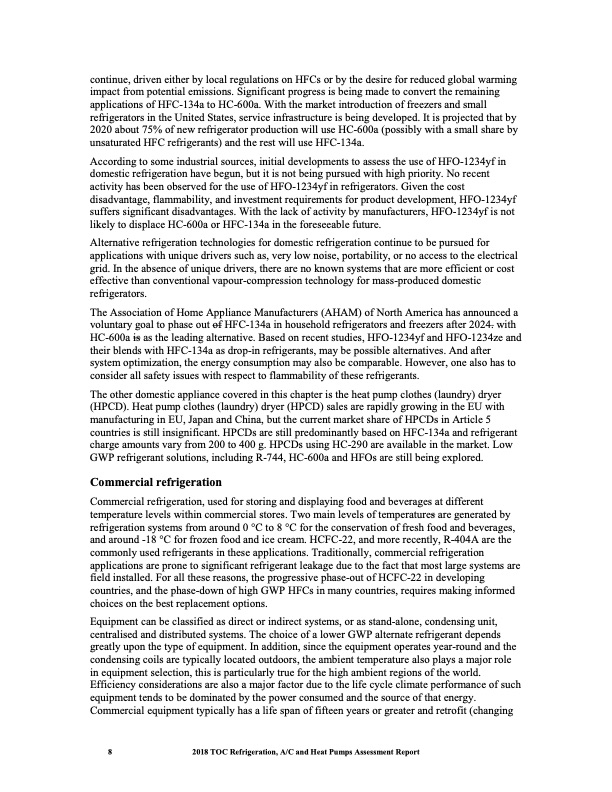
PDF Publication Title:
Text from PDF Page: 021
continue, driven either by local regulations on HFCs or by the desire for reduced global warming impact from potential emissions. Significant progress is being made to convert the remaining applications of HFC-134a to HC-600a. With the market introduction of freezers and small refrigerators in the United States, service infrastructure is being developed. It is projected that by 2020 about 75% of new refrigerator production will use HC-600a (possibly with a small share by unsaturated HFC refrigerants) and the rest will use HFC-134a. According to some industrial sources, initial developments to assess the use of HFO-1234yf in domestic refrigeration have begun, but it is not being pursued with high priority. No recent activity has been observed for the use of HFO-1234yf in refrigerators. Given the cost disadvantage, flammability, and investment requirements for product development, HFO-1234yf suffers significant disadvantages. With the lack of activity by manufacturers, HFO-1234yf is not likely to displace HC-600a or HFC-134a in the foreseeable future. Alternative refrigeration technologies for domestic refrigeration continue to be pursued for applications with unique drivers such as, very low noise, portability, or no access to the electrical grid. In the absence of unique drivers, there are no known systems that are more efficient or cost effective than conventional vapour-compression technology for mass-produced domestic refrigerators. The Association of Home Appliance Manufacturers (AHAM) of North America has announced a voluntary goal to phase out of HFC-134a in household refrigerators and freezers after 2024. with HC-600a is as the leading alternative. Based on recent studies, HFO-1234yf and HFO-1234ze and their blends with HFC-134a as drop-in refrigerants, may be possible alternatives. And after system optimization, the energy consumption may also be comparable. However, one also has to consider all safety issues with respect to flammability of these refrigerants. The other domestic appliance covered in this chapter is the heat pump clothes (laundry) dryer (HPCD). Heat pump clothes (laundry) dryer (HPCD) sales are rapidly growing in the EU with manufacturing in EU, Japan and China, but the current market share of HPCDs in Article 5 countries is still insignificant. HPCDs are still predominantly based on HFC-134a and refrigerant charge amounts vary from 200 to 400 g. HPCDs using HC-290 are available in the market. Low GWP refrigerant solutions, including R-744, HC-600a and HFOs are still being explored. Commercial refrigeration Commercial refrigeration, used for storing and displaying food and beverages at different temperature levels within commercial stores. Two main levels of temperatures are generated by refrigeration systems from around 0 °C to 8 °C for the conservation of fresh food and beverages, and around -18 °C for frozen food and ice cream. HCFC-22, and more recently, R-404A are the commonly used refrigerants in these applications. Traditionally, commercial refrigeration applications are prone to significant refrigerant leakage due to the fact that most large systems are field installed. For all these reasons, the progressive phase-out of HCFC-22 in developing countries, and the phase-down of high GWP HFCs in many countries, requires making informed choices on the best replacement options. Equipment can be classified as direct or indirect systems, or as stand-alone, condensing unit, centralised and distributed systems. The choice of a lower GWP alternate refrigerant depends greatly upon the type of equipment. In addition, since the equipment operates year-round and the condensing coils are typically located outdoors, the ambient temperature also plays a major role in equipment selection, this is particularly true for the high ambient regions of the world. Efficiency considerations are also a major factor due to the life cycle climate performance of such equipment tends to be dominated by the power consumed and the source of that energy. Commercial equipment typically has a life span of fifteen years or greater and retrofit (changing 8 2018 TOC Refrigeration, A/C and Heat Pumps Assessment ReportPDF Image | Heat Pumps Technical Options

PDF Search Title:
Heat Pumps Technical OptionsOriginal File Name Searched:
RTOC-assessment-report-2018_0.pdfDIY PDF Search: Google It | Yahoo | Bing
CO2 Organic Rankine Cycle Experimenter Platform The supercritical CO2 phase change system is both a heat pump and organic rankine cycle which can be used for those purposes and as a supercritical extractor for advanced subcritical and supercritical extraction technology. Uses include producing nanoparticles, precious metal CO2 extraction, lithium battery recycling, and other applications... More Info
Heat Pumps CO2 ORC Heat Pump System Platform More Info
| CONTACT TEL: 608-238-6001 Email: greg@infinityturbine.com | RSS | AMP |